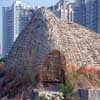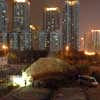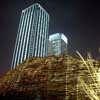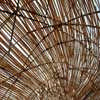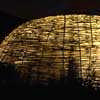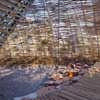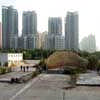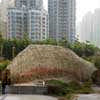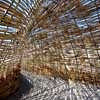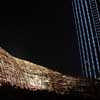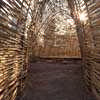Bug Dome SZHK, Hong Kong Building Project Photos, Marco Casagrande Design China, Images
Bug Dome Shenzhen by WEAK!
SZHK Biennale 2009, Asia
14 Dec 2009
Bug Dome
Architects: WEAK!
Event: Shenzhen – Hong Kong Biennale
Photos © Marco Casagrande
Location: Shenzhen, China
Bug Dome
The building is realized on a wasteland of a ruined building site in-between the Shenzhen City Hall and an illegal workers camp. The design is inspired by insects. The bamboo construction methods are based on local knowledge from rural Guanxi brought into the city by the migrating construction workers.
The space is used during the SZHK Biennale for underground bands, poetry reading, discussions, karaoke and as a lounge for the illegal workers from the neighboring camp. The building offers a shade, a stage and a fireplace. After the Biennale the Bug Dome will act as an un-official social club for illegal workers from the Chinese countryside.
The building is weak, flexible and improvised to meet the site-specific conditions. It is growing from a ruin. The architectural control has been given up in order to let the nature step in. The weak architecture is a mediator between the human nature and nature. The construction is a result of participatory planning between the designers, construction workers and local knowledge. The design is by WEAK! – a joint venture with Marco Casagrande’s C-Laboratory.
The cocoon is a weak retreat for the modern man to escape from the strength of the exploding urbanism in the heart of Shenzhen. It is a shelter to protect the industrial insects from the elements of un-nature.
When the fire is up a society is born again. One has to take the liberty to travel a thousand years back in order to realize that the things are the same.
Let everything that has been planned come true.
Let them believe. And let them have a laugh at their passions. Because what they call passion actually is not some emotional energy but just a friction between their souls and the outside world.
And most important: let them believe in themselves. Let them be helpless like children, because: weakness is a great thing and strength is nothing.
– ‘Stalker’, Andrei Tarkovsky
Bug Dome by the WEAK!
The bug dome is a result of discussions between Marco Casagrande, Hsieh Ying-chun and Roan Ching-yueh. Together we are the WEAK! Insects inspire our construction methods. WEAK! Architects are the industrial insects.
The design process was painful. We were all ripping the design to all three individual directions but in the end we gave up and the design became the boss and we learned to listen. Architecture gives the commands and architects listen.
To design is not enough. Design should not replace reality. The building must grow from the site; it must react for its surroundings, it must reflect life and it must let to be itself, like any other living creature. Architectural control is against nature and it is against architecture. Built human environment is a mediator between human nature and nature. Man must be weak to be part of nature.
When the ‘design’ was brought to the site, the site got to it. The interpreters between the site and the design were the construction workers. Our team came from the rural areas of Guanxi, Henan and Sichuan. They bought to the city with them the connection between the modern men and nature – local knowledge. The same hands that build the Bug Dome have also build the modern Shenzhen. Shenzhen is a manifest of control; Bug Dome is manifest of weakness.
What comes to architectural control, we must give up in order for the nature to step in and for the human nature as part of nature.
Our construction workers were sensitive, creative and responsible.
They knew how to construct nature as insects do. As architects we had to become part of them to gain soft, organic and moving space.
In large scale, if we learn to understand the connection what the hundreds of millions of hands that are now migrating from the rural China to the modern cities might bring along them, we might be able to ruin the industrial city. We might be able to make the city to be part of nature.
Architecture of the WEAK!
Text by Robin Peckham
As mentioned previously, one of the densest and most ambivalent projects in the 2009 Shenzhen & Hong Kong Bi-City Biennale of UrbanismArchitecture is the ‘Bug Dome’ pavilion installed on the outdoor space northeast of the Shenzhen Civic Center. The sculptural space is designed by WEAK! Architects, a collective consisting of Hsieh Ying-Chun, the Taiwanese architect best known for his philosophy of architecture as social activism, Roan Ching-Yueh, a Taiwanese architectural curator dealing with many of the same issues, and Marco Casagrande, a Finnish architect interested in structural ecologies and all manner of new age theories of spiritual construction.
Their project here is formally interesting, forming a loosely woven shell amenable to both open air performances and more casual social activities along the lines of Hsieh Ying-Chun’s former projects with tent-based amphitheaters in suburban Taipei. Its shape recalls a partially submerged cicada skin, semi-translucent and emerging organically from the ground. It is constructed of solid bamboo ribs shaped into arches perpendicular to the length of the sculpture, while thinner strips of bamboo are woven between these ribs.
Broken bricks and mud lend support like primitive buttresses. Although it is physically possible to enter from either end, one side houses a flat stage, and the remaining ground surface is covered with small stones that conceal upward-facing electric lights. The structure is immediately placed on an overgrown construction site immediately abutting a residential camp for temporary workers, but the skyscrapers and official municipal buildings of Shenzhen are visible on the remaining three sides.
I first experienced the ‘Bug Dome’ one day before the official opening, when project curator Xu Ya-Zhu invited the Taiwanese participants in the biennale to host a small event in and around the structure. Unfortunately Hong Kong poets Liang Wendao and Liu Wai Tong did not make it in time for their scheduled readings, so instead a discussion with the architects was held on the makeshift stage.
The ensuing conversation strayed quite far from the subtle aesthetic ambiguities of the project itself, and several participants proceeded to negate the urban experience with an at times naive and utopian tirade on the merits of rural communities. Notably, Roan Ching-Yueh mentioned that architecture has no reason to become remain as complicated as it has become, that civilization did not appear out of a vacuum in the early 20th century, and that there is no reason to pay the government to dispose of our waste.
All three of these architects deserve the utmost respect for their suspicion of breakneck urbanization and Futurist urbanism, and even more so for their willingness to work with vernacular materials and styles in the service of disadvantaged rural communities. Some of their projects, including Marco Casagrande’s work on the Treasure Hill area in Taipei, have been absolutely groundbreaking in terms of how we think about the limits of growth for the Chinese cities of the future.
But an inability to accept multiple planes of construction and levels of systemic integration is simply futile. The ‘Bug Dome’ successfully negotiates the territory between the construction, metropolitan architecture, and rural past of Shenzhen, but it is not a habitable structure. It would be foolish to claim that this kind of work could represent any kind of solution ‘even theoretical’ to the problems facing south China.
Thankfully, the architects also distributed a broadsheet paper called ‘Cicada’ during the opening days of the biennale. The textual and visual materials contained therein lay out the discursive basis for these projects sensibly and realistically, a far cry from the rhetoric that led me to all but dismiss the pavilion during that opening event.
In this conception, ‘weakness’ is a form of architecture based on insect construction, rejecting engineering in favor of a bricolage that collects debris from around the site for its structural materials. In a remarkable conceptual move, the figure of the ruin is viewed as a form of third-generation urbanism in which the man-made is integrated into natural systems.
WEAK! projects are thus paradoxical attempts at the design of ruins.
In another project, the ‘Post-Industrial Fleet’, decommissioned commercial ships are berthed outside of Tianjin and inhabited as units for residence, recreation, and survival. What is at stake here is often the scale of the design of systems: although Roan Ching-Yueh may have overstated his case when he claimed that there is never a need to choose the ‘big system’ over the ‘ittle system’, this is indeed a category of analysis to which more attention needs to be paid. This is something akin to open-source architecture, consisting of shanzhai hardware components that can be remixed and recombined according to the exigencies of the moment. In southern China, there may be no other way.
http://kunsthallekowloon.org/archives/111
Bug Dome Shenzhen – Building Information
Design: The WEAK!
Architects: Hsieh Ying-chun, Marco Casagrande, Roan Ching-yueh
Construction Work: Chen, Jiang Zhou, Leo Cheng, Marco Casagrande, Nikita Wu, Shao Lei, Wei Jia-kuan, Wei Jing-Ke
Design Assistant: Frank Chen
Local Knowledge: Wei Jia-kuan, Wei Jing-Ke
Location: Shenzhen, China
Site: 3000 m2 waste land, ruined building site Building footprint: 120 m2
Materials: bamboo, wood, gravel, recycled concrete
Completed: 2009
Bug Dome images / information from Marco Casagrande architect, C-Laboratory / Built Human Environment
Location: Shenzhen, Eastern Asia
Shenzhen Architecture Designs
Shenzhen Architectural Designs
Hong Kong Architecture Designs – chronological list
Hong Kong Architecture Tours by e-architect
Shenzhen Architecture Biennale 2013
Key C-Laboratory Projects
Chen House, north Taiwan
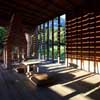
image from architect
Chen House
Treasure Hill, Taipei City, Taiwan
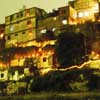
image from architect
Treasure Hill Taipei
Shenzhen Hong Kong Biennale Installation – added : Ball Nogues Studio
Key Shenzhen Design
Shenzhen 4 in 1 Towers
MVRDV
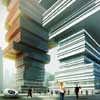
picture © MVRDV
Shenzhen 4 in 1 Towers
Shenzhen Hong Kong Biennale – Terence Riley : Chief Curator
Hong Kong Architecture – Selection
West Kowloon Development
Foster + Partners
West Kowloon Cultural Complex
International Finance Centre, Central
Cesar Pelli & Associates Architects, Rocco Design, Hirsch Bedner Associates
IFC 2 skyscraper
Innovation Tower, The Hong Kong Polytechnic University – PolyU
Zaha Hadid Architects
Hong Kong University Building
Comments / photos for the Bug Dome Hong Kong Architecture page welcome

